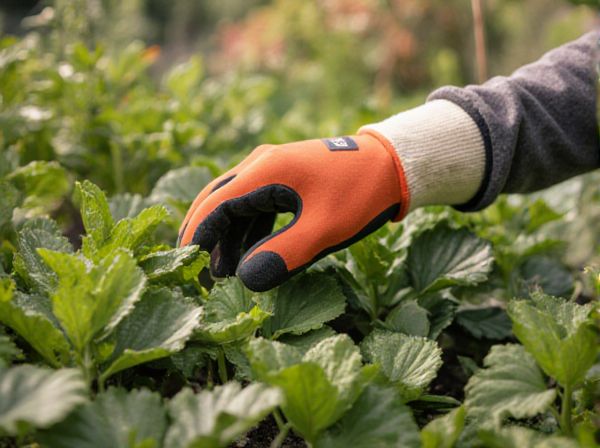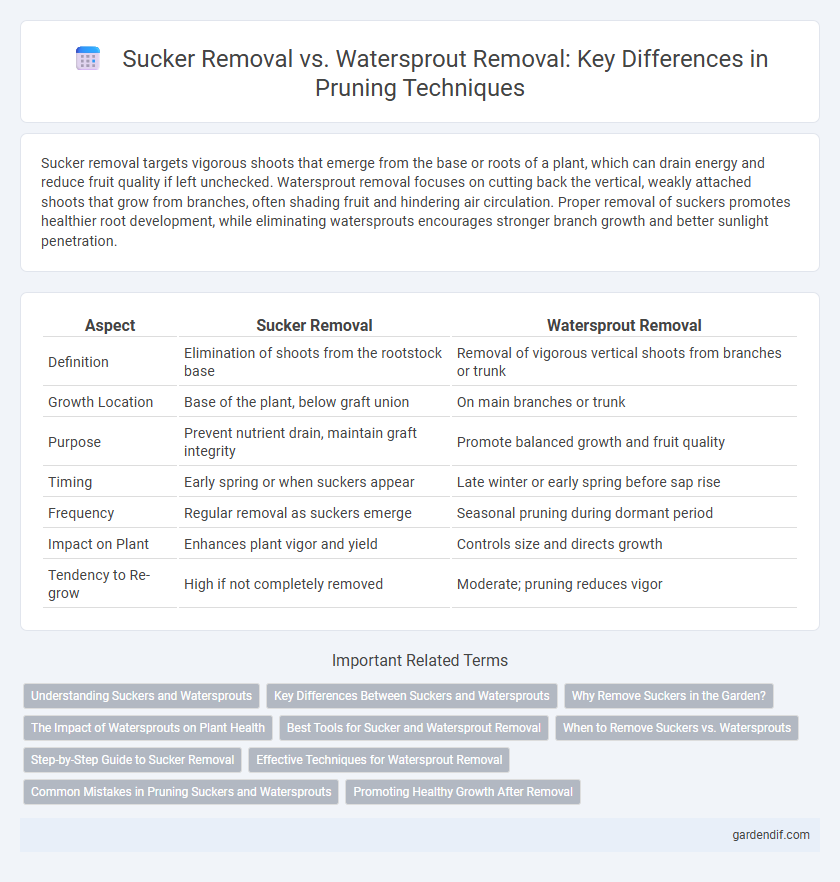
Sucker removal vs watersprout removal Illustration
Sucker removal targets vigorous shoots that emerge from the base or roots of a plant, which can drain energy and reduce fruit quality if left unchecked. Watersprout removal focuses on cutting back the vertical, weakly attached shoots that grow from branches, often shading fruit and hindering air circulation. Proper removal of suckers promotes healthier root development, while eliminating watersprouts encourages stronger branch growth and better sunlight penetration.
Table of Comparison
| Aspect | Sucker Removal | Watersprout Removal |
|---|---|---|
| Definition | Elimination of shoots from the rootstock base | Removal of vigorous vertical shoots from branches or trunk |
| Growth Location | Base of the plant, below graft union | On main branches or trunk |
| Purpose | Prevent nutrient drain, maintain graft integrity | Promote balanced growth and fruit quality |
| Timing | Early spring or when suckers appear | Late winter or early spring before sap rise |
| Frequency | Regular removal as suckers emerge | Seasonal pruning during dormant period |
| Impact on Plant | Enhances plant vigor and yield | Controls size and directs growth |
| Tendency to Re-grow | High if not completely removed | Moderate; pruning reduces vigor |
Understanding Suckers and Watersprouts
Suckers are vigorous shoots that emerge from the rootstock or base of the tree, often diverting essential nutrients away from the main branches and affecting overall tree health. Watersprouts grow rapidly from the trunk or older branches, creating dense, vertical growth that can shade inner foliage and reduce fruit production. Proper identification and removal of both suckers and watersprouts are crucial for maintaining tree structure, improving air circulation, and enhancing fruit quality in pruning practices.
Key Differences Between Suckers and Watersprouts
Suckers and watersprouts differ primarily in their origin and growth patterns, with suckers emerging from the rootstock or base of the plant, while watersprouts grow vertically from dormant buds on the branches or trunk. Suckers often have weaker tissues and can divert nutrients away from the main plant, whereas watersprouts tend to be vigorous but can create dense, unproductive growth. Proper pruning involves removing suckers to maintain plant health and selectively thinning watersprouts to improve air circulation and light penetration.
Why Remove Suckers in the Garden?
Removing suckers in the garden is essential to direct the plant's energy toward producing healthier fruits and flowers instead of excessive, non-productive growth. Suckers emerge from the rootstock or main stem, often crowding the plant and increasing susceptibility to pests and diseases. Effective sucker removal improves air circulation and sunlight penetration, promoting overall plant vigor and maximizing garden yield.
The Impact of Watersprouts on Plant Health
Watersprouts negatively impact plant health by diverting essential nutrients and energy away from fruit-bearing branches, leading to reduced yield and weakened structural integrity. Unlike suckers, which typically emerge from the base and can be removed with minimal impact, watersprouts grow vigorously on branches and compete directly with the plant's main framework. Effective removal of watersprouts is crucial to maintaining balanced growth, preventing overcrowding, and ensuring optimal photosynthesis and nutrient distribution.
Best Tools for Sucker and Watersprout Removal
The best tools for sucker and watersprout removal include bypass pruners, loppers, and hand saws, each selected based on branch thickness and accessibility. Bypass pruners are ideal for small, flexible suckers, providing precise cuts that promote healthy regrowth, while loppers with longer handles efficiently trim thicker suckers and watersprouts. For larger watersprouts, a pruning saw with sharp, curved blades ensures clean cuts that minimize tissue damage and reduce the risk of disease transmission.
When to Remove Suckers vs. Watersprouts
Remove suckers early in the growing season when they emerge from the rootstock to prevent nutrient diversion from the main vine. Watersprouts should be pruned during dormancy or early spring before bud break to maintain proper canopy structure and improve fruit exposure. Timely removal of both suckers and watersprouts promotes healthy growth and increases vineyard productivity.
Step-by-Step Guide to Sucker Removal
Sucker removal involves cutting shoots that grow from the base or roots of a plant to prevent energy diversion and improve overall health, while watersprout removal targets vigorous, upright shoots growing from branches. To effectively remove suckers, start by identifying shoots emerging below the graft union or near the soil line, then use clean, sharp pruning shears to cut them as close to their origin as possible without damaging the main stem. Regular monitoring and removal of suckers during the growing season promote stronger plant growth and more fruitful development.
Effective Techniques for Watersprout Removal
Effective techniques for watersprout removal include precise pruning cuts made close to the main branch to prevent regrowth and the use of sharp, sterilized tools to minimize plant stress and infection risk. Applying targeted pruning during the dormant season optimizes healing and reduces the likelihood of vigorous new growth, while mulching around the base can suppress suckers but is less effective against watersprouts. Consistent monitoring and removal of watersprouts in early stages help maintain tree health and improve overall structure by redirecting energy to desired branches.
Common Mistakes in Pruning Suckers and Watersprouts
Common mistakes in pruning suckers include cutting too close to the main trunk, causing unnecessary damage, or leaving stubs that encourage further growth. Watersprout removal errors often involve neglecting to prune early, resulting in dense, weak shoots that drain the tree's energy. Proper timing and clean cuts at the branch collar are essential to prevent disease and promote healthy growth.
Promoting Healthy Growth After Removal
Sucker removal promotes healthy growth by redirecting the plant's energy toward the main stem and primary branches, reducing competition for nutrients and improving airflow. Removing watersprouts helps restore the natural structure of the tree, preventing weak, vertical shoots that drain resources and hinder fruit production. Both practices are essential for maintaining vigor and encouraging productive, well-balanced growth after pruning.
Sucker removal vs watersprout removal Infographic

 gardendif.com
gardendif.com